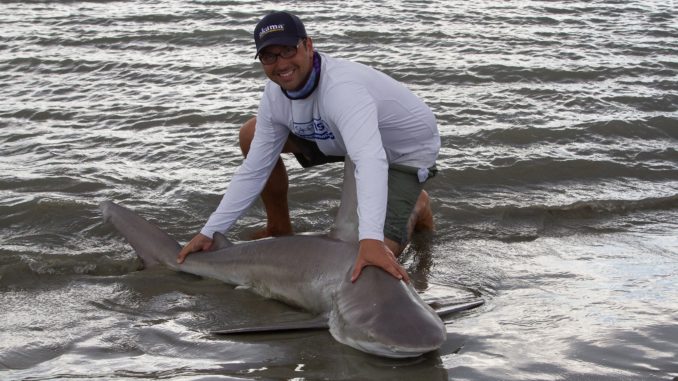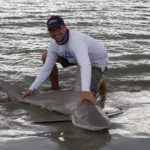
Special tactics, tackle are required to target big sharks from the shoreline.
With the full moon lighting the ocean’s surface, Mike Popovich of Requiem Fishing made his way through the breaking surf in a small kayak, a large baitfish lying in the hull. The baitfish was hooked to a monofilament leader and line that stretched back to his rod and reel, which stood tall in a sand spike on the beach.
He paddled 200 yards, dropped his bait, paddled back to shore, stepped out of the kayak with burning arms and heard the high-pitched “ZZZ-ZZZZZ-ZZZZZZIIIIIIING” of line being pulled at a high rate of speed off of his Avet reel. Just that quickly, he was hooked up.
Popovich strapped into his rod harness, and against the odds, calmly began applying drag to the reel, which continued to spit out line until the drag took hold and Popovich felt the line tighten. The fight was on.
“The shark only made one initial burst, but the whole time, it felt like a 2-ton truck anchored in the sand. It felt heavy, (but) the size of the dorsal fin took us all by surprise,” said Popovich, who was even more surprised, Stan Warren, Requiem’s captain, called out, “It’s a hammer!”
The 6-foot-6 scalloped hammerhead shark was a rare catch in South Carolina waters, and quickly as Popovich got it close to the beach, the rest of Charleston-based Team Requiem was in the surf, roping the shark’s tail, taking measurements, and snapping photos.
“This shark was out of the water for probably two minutes, at most,” said Popovich, who returned the fish to the water as quickly as possible.
Shark fishing from the surf is not the most-popular form of fishing in South Carolina, but it’s tough to beat the excitement of reeling in a massive, prehistoric beast with your feet planted in the sand and your body strapped to gear that physically connects you to the shark — and gives the shark the potential to pull you into his world.
“Fishing from a boat is one thing; you’re going into their territory. But standing on land and bringing a creature that size to our territory is a thrill that can’t be duplicated,” said Blanding Levin, another team member.
Fishing this way isn’t a big numbers game. Catching three sharks 6-footers on any given night is usually considered a successful trip, especially if one measures more than 7 1/2 feet. But that doesn’t mean anglers are sitting around doing nothing that whole time. Catching bait with smaller rods and reels takes up a good bit of time, and checking bait and resetting lines is a time-consuming process that involves reeling in hundreds of yards of line, re-tying knots, then kayaking through the surf to drop fresh bait.
Most anglers anchor the bait in place with a weight that features wire arms to help it dig into the sand. If the arms don’t hold firmly, the bait gets washed away with the tide, often drifting parallel to the shoreline until the tide washes it ashore. Weights typically range from 6 up to 16 ounces.
Reels are not run-of-the-mill surf-fishing reels. but huge ones typically used offshore for billfish, tuna and dolphin. The Okuma Makaira SEA 15s are considered small, with Shimano Tiagra 30Ws on up to Everol 12/0s and Avet MXLs being the most common for hunting these big sharks from shore.
Line is also beefier than what you usually find on a surf reel, with 50-pound test the lightest you’ll ever see, and 100- to 200-pound line more common, and 500 to 800 yards on the spool. Many fishermen prefer a combination of Jerry Brown mono for their running line and 200 yards of Soft Steel mono for a leader, Because it has a diameter of 1.3 millimeters compared to 1.5 for other mono of comparable size, the fishermen can pack more line onto their reels — a necessity when fighting trophy class sharks.
Warren said that while sharks usually make only one or two runs, their runs often cover hundreds of yards.
Hooks in the 16/0 range are typical, and Warren prefers to use circle hooks, which he said usually end up in the corner of a shark’s mouth, usually making removal fairly easy once a shark is beached.
Rods are usually short and stiff, in line with what tuna anglers use from boats. The most-common brand among Requiem’s anglers is made by one of the team members, Russell Shipe, and is appropriately branded as Requiem Rods.
As far as strategy goes, Warren said it’s best to fish in an area with a deep drop-off. This is usually in a sound rather than the open ocean, because sounds have deeper holes, and sharks like hanging out in these areas. Keeping a fighting belt nearby is essential, and anglers often strap themselves into the harness at the first sign of a bite.
When a shark makes its initial run, it usually doesn’t know it’s hooked, so setting the hook at the right time is crucial, and is sometimes a bit of a guessing game.
“It’s different with every bite, so you just have to develop a feel for when to do it. Sometimes you’re right, and you’ll feel it as soon as the hook finds paydirt. Sometimes you’re wrong and miss. That’s all a part of it,” said Levin.
It’s always good to have several people fishing together. As Popovich mentioned, land-based shark fishing is not a one-man show by any means, especially when you want to measure and document your catches. And the more baits you have out, the better your chances of hooking up. Anglers usually accomplish this by setting out a line of several rods where the surf gives way to sand. The rods are set at intervals that allow each angler plenty of room to work, with smaller bait rods often set up in between, just to keep fresh, local bait available.
It’s impossible to make a cast with the preferred tackle, and there’s where the kayak comes in handy. When an angler is ready to set baits, he paddles straight out from his rod with his bait onboard, anywhere from 100 to 300 yards, depending on the area being fished. While he’s paddling, another angler makes sure the line spools evenly off the reel, then ensures the sinker takes hold. Otherwise, by the time the first angler kayaks back to shore, the sinker and bait could be there waiting on him.
That kind of teamwork is essential for the safety and well-being of anglers and sharks alike when landing one. Warren has experienced his share of heartbreak when a shark has rolled onto the leader while in very shallow water, breaking the line and heading for deep water before anglers can consider the shark caught. So with one man handling the rod, another will slip a heavy rope around the shark’s tail and drag it ashore, where other team members quickly remove the hook, tag the shark with an NOAA device, measure it, photograph it, then remove the rope and free the shark.
While Team Requiem (www.requiemfishing.com) competes in a number of regional and national tournaments like the annual Big Hammer Challenge, they fish mostly for fun and to introduce new anglers to the sport through their charter service. They give beginning land-based shark anglers a trial with top-notch equipment and knowledgeable shark anglers who have encountered countless scenarios that would likely leave a first-timer holding a broken fishing line at best, and getting pulled into the water by the shark at worst.






Be the first to comment